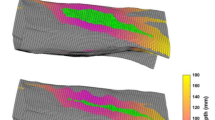Abstract
We evaluated the electrical events and the resulting shock waves of the spark discharge for electrohydraulic lithotripsy at the tip of a 3.3F probe. Spark generation was achieved by variable combinations of voltage and capacity. The effective electrical output was determined by means of a high-voltage probe, a current coil, and a digital oscilloscope. Peak pressures, rise times, and pulse width of the pressure profiles were recorded using a polyvinylidene difluoride needle hydrophone in 0.9% NaCl solution at a distance of 10 mm. The peak pressure and the slope of the shock front depend solely on the voltage, while the pulse width was correlated with the capacity. Pulses of less than 1-μs duration can be obtained when low capacity is applied and the inductivity of the cables and plugs is kept at a low level. Using chalk as a stone model it was proven that short pulses of high peak pressure provided by a low capacity and a high voltage have a greater impact on fragmentation than the corresponding broader shock waves of lower peak pressure carrying the same energy.
Similar content being viewed by others
References
Angeloff A (1972) Hydro electrolithotripsy. J Urol 108: 867–871
Coleman AJ, Saunders JE (1989) A survey of the acoustic output of commercial extracorporeal shock wave lithotripters. Ultrasound Med Biol 15: 213
Eaton JM, Malin JM, Glenn JF (1972) Electrohydraulic lithotripsy. J Urol 108: 865–866
Goodfriend R (1984) Ultrasonic and electrohydraulic lithotripsy of ureteral calculi. Urology 23: 5–8
Harrison J, Morris DL, Haynes J, Hitchcock A, Womack C, Wherry DC (1987) Electrohydraulic lithotripsy of gall stones—in vitro and animal studies. Gut 28: 267–271
Lamport H, Newman HF (1984) Ultrasonic lithotresis in the ureter. J Urol 76: 520–529
Marberger M (1983) Disintegration of renal and ureteral calculi with ultrasound. Urol Clin North Am 10: 729–742
Reuter HJ (1970) Electronic lithotripsy: transurethral treatment of bladder stones in 50 cases. J Urol 104: 834–838
Reuter HJ, Kern E (1973) Electronic lithotripsy of ureteral calculi. J Urol 110: 181–183
Schoborg TW (1989) Efficacy of electrohydraulic and laser lithotripsy in the ureter. J Endourol 3: 361–365
Sievert CE, Silvis SE (1987) Evaluation of electrohydraulic lithotripsy as a mean of gallstone fragmentation in a canine model. Gastrointest Endosc 33: 233–235
Vorreuther R, Engelking R (1992) Features and acoustic output of five different electrohydraulic lithotripters for endoureteral stone treatment. J Endourol 6: 41–45
Vorreuther R, Engelking R (1992) Minimally invasive ureteroscopy using adjustable electrohydraulic lithotripsy. J Endourol 6: 47–50
Watson G, Murray S, Dretler SP, Parrish JA (1987) The pulsed dye laser for fragmenting urinary calculi. J Urol 138: 195–198
Watson G, Murray S, Dretler SP, Parrish JA (1987) An assessment of the pulsed dye laser for fragmenting calculi in the pig ureter. J Urol 138: 199–202
Author information
Authors and Affiliations
Rights and permissions
About this article
Cite this article
Vorreuther, R., Engelmann, Y. Evaluation of the shock-wave pattern for endoscopic electrohydraulic lithotripsy. Surg Endosc 9, 42–45 (1995). https://doi.org/10.1007/BF00187883
Received:
Accepted:
Issue Date:
DOI: https://doi.org/10.1007/BF00187883




